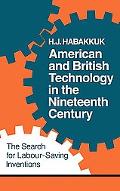
American and British Technology in the Nineteenth Century: The Search for Labour-Saving Inventions PDF
Preview American and British Technology in the Nineteenth Century: The Search for Labour-Saving Inventions
According to the Habakkuk Thesis, the underlying stimulus of American technological progress was the scarcity of labor in the first half of the 19th century. In American and British Technology in the Nineteenth Century: The Search for Labor-Saving Inventions, Habakkuk writes, “It seems obvious -- it certainly seemed so to contemporaries -- that the dearness and inelasticity of American, compared to British, labour gave the American entrepreneur with a given capital a greater inducement that his British counterpart to replace labour by machines”.
Labor scarcity was induced by the abundance of cheap, fertile land in the United States, which meant that many people resorted to agriculture because earnings and output were both high and accrued to the cultivator. Since returns to agriculture were high, this caused industrial wages to rise for the manufacturing sector to attract workers. This increase in wages and costs provoked companies to search for a more mechanized method that saved labor. Habakkuk proposed that America ended up choosing a more capital-intensive technique of manufacturing in order to conserve labor. To further his argument he points out that increased demand for labor in the early 19th century raised the wages of unskilled labor more than that of skilled labor. The shortage of labor was mainly felt in the division of unskilled labor, which caused the disparity between wages of skilled and unskilled workers. In many cases, the capital-intensive technique of manufacturing required more skilled labor than the labor-intensive technique. And since wages for skilled labor were lower relative to unskilled labor, it rationalized the push for capital-intensive and labor saving innovations. In return, companies sought to mechanize the simple operations of the costly unskilled workers.
